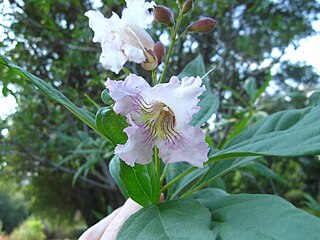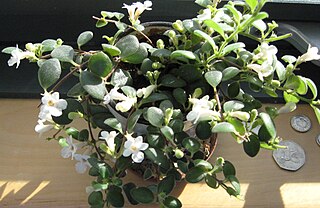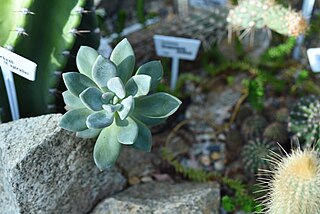 W
W× Phyllosasa is a nothogenus of Japanese bamboo in the grass family.
 W
WThe scientific name × Amarcrinum is applied to those hybrid plants obtained from artificial crosses between the genera Amaryllis and Crinum, although as of March 2014, the World Checklist of Selected Plant Families regards the name as "unplaced". They are grown as ornamental plants in gardens.
 W
W× Amelasorbus is a flowering plant in the family Rosaceae. A naturally occurring hybrid, it is the result of a cross between two distinct tree genera, Amelanchier and Sorbus, and shows phenotypic similarities to both parents. This type of intergeneric hybrid is quite rare, and is indicated by a multiplication symbol before the name. The name Amelasorbus is an example of a portmanteau word, a combination of the two parents' names.
 W
W× Astrolista is a nothogenus of naturally occurring inter-generic hybrids in the Little Karoo region of the Western Cape Province, South Africa.
 W
W× Chitalpa is an intergeneric hybrid flowering tree in the family Bignoniaceae. There are two major forms in North America, the 'Morning Cloud' a hybrid of desert willow for desert hardiness and color, and northern catalpa, and the 'Pink Dawn' variety formed as a hybrid of desert willow and either yellow catalpa or northern catalpa. Both forms were originally thought to be hybrids of Desert Willow and Southern Catalpa. The name is nothogeneric, or a combination of the two parents' names. Leaves are lanceolate, 10 to 13 cm long and 2.5 cm (1 in) wide, almost always in whorls of three. The trumpet-shaped flowers are 2.5 cm (1 in) long and frilly. The inflorescence is indeterminate, with alternately arranged flowers.
 W
WCodonanthe is a genus of mainly epiphytic plants in the family Gesneriaceae, endemic to the Atlantic Forest of Brazil. The botanical name comes from the Ancient Greek for 'bellflower'. They have white or pale pink flowers and somewhat fleshy leaves. In 2013, the genus was reduced in size when more than half of the species were transferred to Codonanthopsis. They can be grown as houseplants, particularly in hanging baskets. Artificial crosses with Nematanthus hybrids have produced the hybrid genus × Codonatanthus.
 W
W× Cremnosedum is a hybrid genus produced from crosses involving the genera Cremnophila and Sedum. This bigeneric name was first published in 1981 with the introduction of the cultivar 'Little Gem' in an article advertising plants offered by the International Succulent Institute in the Cactus and Succulent Journal, the journal of the Cactus and Succulent Society of America. The 'Little Gem' cultivar was made by Mrs. and Mr. Robert Grim of San Jose, California and is described as producing a low mat of small rosettes. It prefers direct sunlight and produces small yellow flowers on short stalks.
 W
WThe plants known as epiphyllum hybrids, epiphyllums, epicacti, or just epis, as well as orchid cacti, which are widely grown for their flowers, are artificial hybrids of species within the group of cacti placed in the tribe Hylocereeae, particularly species of Disocactus, Pseudorhipsalis and Selenicereus. In spite of the common name, species in the genus Epiphyllum are less often involved as parents of epiphyllum hybrids.
 W
W× Gasteraloe is a genus of hybrid plants, from mixtures of species from the Aloe or Aristaloe and Gasteria genera.
 W
W× Pachyveria is a hybrid succulent. They typically grow to 2–6 inches. They grow best in soil full of phosphorus and potassium, but low in nitrogen. Pachyveria are a hybrid cross between Pachyphytum and Echeveria. × Pachyveria glauca 'Little Jewel' is a cultivar of × Pachyveria.
 W
W× Phylliopsis is a nothogenus of flowering plants in the heath and heather family Ericaceae. Artificially created hybrids, they are the result of crosses between species of two distinct heath genera, Kalmiopsis and Phyllodoce. This type of intergeneric hybridization is quite rare, and is indicated by a multiplication symbol before the name. The name Phylliopsis is an example of a portmanteau word, a combination of the two parents' names. The cultivar × Phylliopsis 'Coppelia' has gained the Royal Horticultural Society's Award of Garden Merit. The RHS lists the nominal species name as Phylliopsis hillieri.
 W
WThe shipova is a hybrid of the European pear and the common whitebeam. It is a small to medium-sized tree growing to 10–18 m tall, with deciduous oval leaves 7–11 cm long and 5–6 cm broad. The fruit is a pome 2.5–3 cm long; it is edible with a sweet, yellowish flesh, which tastes similar to a Nashi pear.
 W
WTriticale is a hybrid of wheat (Triticum) and rye (Secale) first bred in laboratories during the late 19th century in Scotland and Germany. Commercially available triticale is almost always a second-generation hybrid, i.e., a cross between two kinds of primary (first-cross) triticales. As a rule, triticale combines the yield potential and grain quality of wheat with the disease and environmental tolerance of rye. Only recently has it been developed into a commercially viable crop. Depending on the cultivar, triticale can more or less resemble either of its parents. It is grown mostly for forage or fodder, although some triticale-based foods can be purchased at health food stores and can be found in some breakfast cereals.